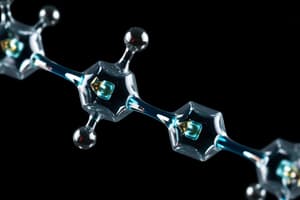Podcast
Questions and Answers
What is the effect of increasing electronegativity across a period on bonding?
What is the effect of increasing electronegativity across a period on bonding?
- It results in a non-polar bond.
- It decreases the strength of the bond.
- It causes electrons to equally share between atoms.
- It increases the attraction of bonding electrons to the nucleus. (correct)
Which atom is the most electronegative?
Which atom is the most electronegative?
- Chlorine
- Nitrogen
- Fluorine (correct)
- Oxygen
What occurs in a polar covalent bond?
What occurs in a polar covalent bond?
- One atom develops a δ+ charge and the other a δ- charge. (correct)
- The bond becomes ionic in nature.
- Electrons are equally shared between the two atoms.
- There is no difference in electronegativity between the atoms.
Why does electronegativity decrease down a group?
Why does electronegativity decrease down a group?
How does the polarity of water relate to its molecular structure?
How does the polarity of water relate to its molecular structure?
What characterizes a polar bond?
What characterizes a polar bond?
What creates bond polarity in covalent bonds?
What creates bond polarity in covalent bonds?
What is a covalent bond primarily characterized by?
What is a covalent bond primarily characterized by?
What describes the relationship between ionic and covalent bonding?
What describes the relationship between ionic and covalent bonding?
Which statement accurately describes a coordinate bond?
Which statement accurately describes a coordinate bond?
What happens to the electrons in a covalent bond between atoms of different electronegativities?
What happens to the electrons in a covalent bond between atoms of different electronegativities?
What type of bond is formed between a metal and a non-metal?
What type of bond is formed between a metal and a non-metal?
Which of the following pairs exemplifies a covalent bond?
Which of the following pairs exemplifies a covalent bond?
Which of the following statements about metallic bonding is true?
Which of the following statements about metallic bonding is true?
In the context of bonding, what does a lone pair refer to?
In the context of bonding, what does a lone pair refer to?
Which type of bond does NOT typically result in a noble gas structure?
Which type of bond does NOT typically result in a noble gas structure?
What type of bond is characterized by the sharing of electrons between two non-metal atoms?
What type of bond is characterized by the sharing of electrons between two non-metal atoms?
Which molecule is an example of a substance that violates the octet rule?
Which molecule is an example of a substance that violates the octet rule?
What results when atoms with significantly different electronegativities bond together?
What results when atoms with significantly different electronegativities bond together?
Which of the following correctly defines electronegativity?
Which of the following correctly defines electronegativity?
In the context of ionic bonding, what occurs to the electrons of the metal atom?
In the context of ionic bonding, what occurs to the electrons of the metal atom?
Flashcards
Ionic Bonding
Ionic Bonding
Electrostatic attraction between oppositely charged ions formed by electron transfer.
Dot and Cross Diagrams
Dot and Cross Diagrams
Visual representation of ionic bonding that shows electron transfer and electron arrangement in ions.
Covalent Bond
Covalent Bond
Electrostatic attraction between a shared pair of electrons and the bonded atoms' nuclei.
Lone Pair
Lone Pair
Signup and view all the flashcards
Coordinate Bond
Coordinate Bond
Signup and view all the flashcards
Bond Polarity
Bond Polarity
Signup and view all the flashcards
Metallic Bonding
Metallic Bonding
Signup and view all the flashcards
Electronegativity
Electronegativity
Signup and view all the flashcards
Octet rule
Octet rule
Signup and view all the flashcards
Electronegativity trend
Electronegativity trend
Signup and view all the flashcards
Limitations of octet rule
Limitations of octet rule
Signup and view all the flashcards
Double covalent bond
Double covalent bond
Signup and view all the flashcards
Polar Covalent Bond
Polar Covalent Bond
Signup and view all the flashcards
Why does electronegativity increase across a period?
Why does electronegativity increase across a period?
Signup and view all the flashcards
Why does electronegativity decrease down a group?
Why does electronegativity decrease down a group?
Signup and view all the flashcards
What is a δ+ charge?
What is a δ+ charge?
Signup and view all the flashcards
What is a δ- charge?
What is a δ- charge?
Signup and view all the flashcards
Example of a polar covalent bond
Example of a polar covalent bond
Signup and view all the flashcards
Ionic vs. Covalent Bonding
Ionic vs. Covalent Bonding
Signup and view all the flashcards
Study Notes
Bonding
- Ionic bonding is the electrostatic attraction between oppositely charged ions formed by electron transfer.
- Covalent bonding is the electrostatic attraction between a shared pair of electrons and the nuclei of the bonded atoms.
- A lone pair is an unshared pair of electrons in the outer shell of an atom.
- A coordinate bond (dative bond) is a shared pair of electrons with both electrons supplied by one atom.
- The octet rule states that atoms tend to gain, lose, or share electrons to achieve eight electrons in their outer shell, but there are exceptions.
- Electronegativity is the extent to which an atom attracts the bonding electrons in a covalent bond. Electronegativity increases across periods and decreases down groups.
- A polar bond is a covalent bond with unequal sharing of bonding electrons, indicated by partial charges (δ+ and δ−). Bond polarity arises from differences in electronegativity.
- Metallic bonding is the attraction between positive ions and delocalized electrons in a lattice.
- Delocalized electrons are outer, mobile electrons that don't stay fixed to one atom but move freely throughout the metal.
Types of Bonding
- Ionic bonds occur between a metal and a non-metal.
- Covalent bonds occur between two non-metals.
- Metallic bonds occur between metal atoms.
Dot and Cross Diagrams
- Dot and cross diagrams illustrate the sharing or transfer of electrons in chemical bonds. They illustrate the outer electrons only.
Revision Questions
- There are revision questions included in the text, covering various aspects of bonding. These are not summarized here.
Studying That Suits You
Use AI to generate personalized quizzes and flashcards to suit your learning preferences.




